Kolo Moser
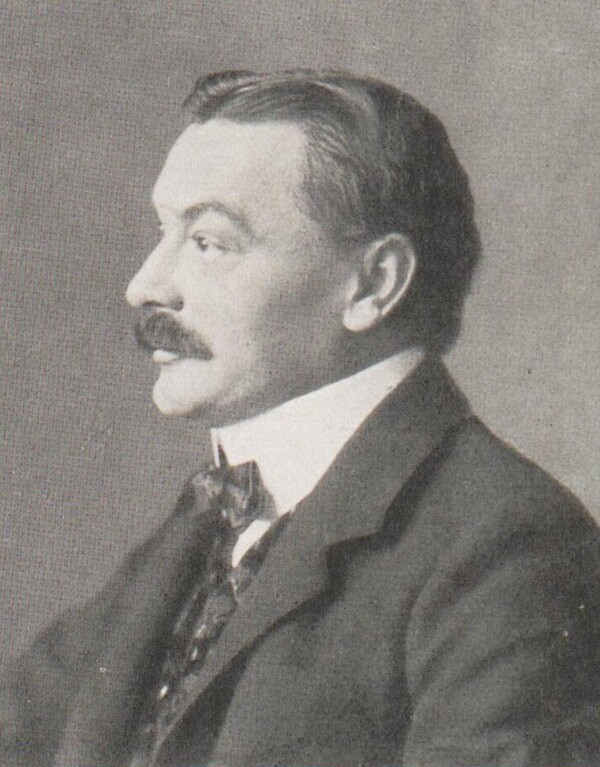
Kolo Moser, in: Deutsche Kunst und Dekoration, Band 62 (1928/29).
© Heidelberg University Library
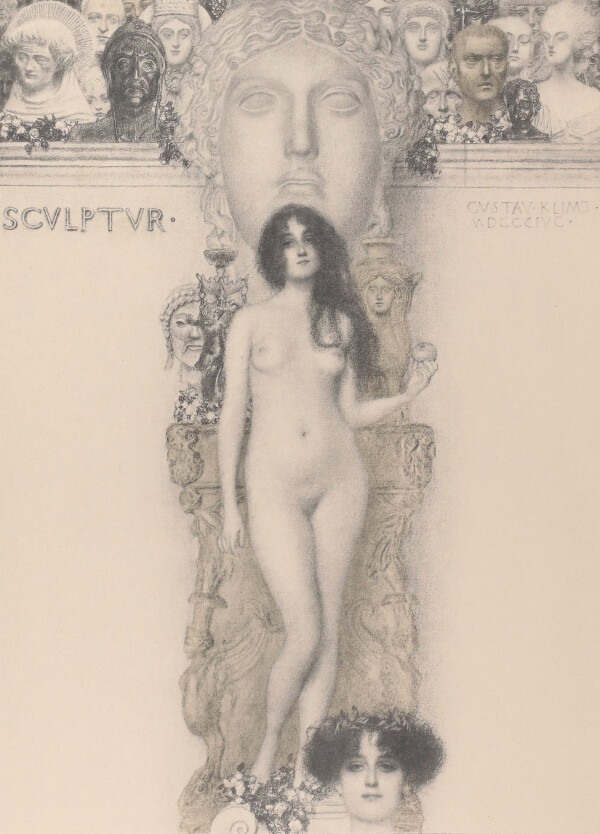
Gustav Klimt: Sculpture, lithograph no. 58 from the portfolio Allegorien. New series, 1896
© Klimt Foundation, Vienna
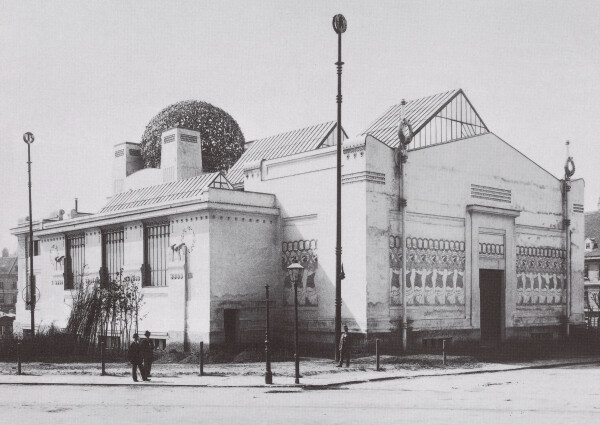
Vienna Association, rear view with the fresco Reigen der Kranzträgerinnen by Kolo Moser, around 1898
© Klimt Foundation, Vienna
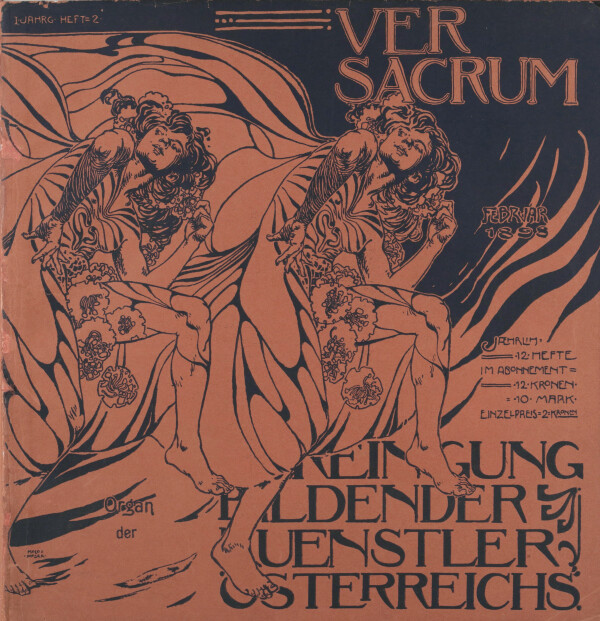
Kolo Moser: Illustrated cover, in: Vereinigung bildender Künstler Österreichs Secession (Hg.): Ver Sacrum. Organ der Vereinigung bildender Künstler Österreichs, 1. Jg., Heft 2 (1898).
© Klimt Foundation, Vienna
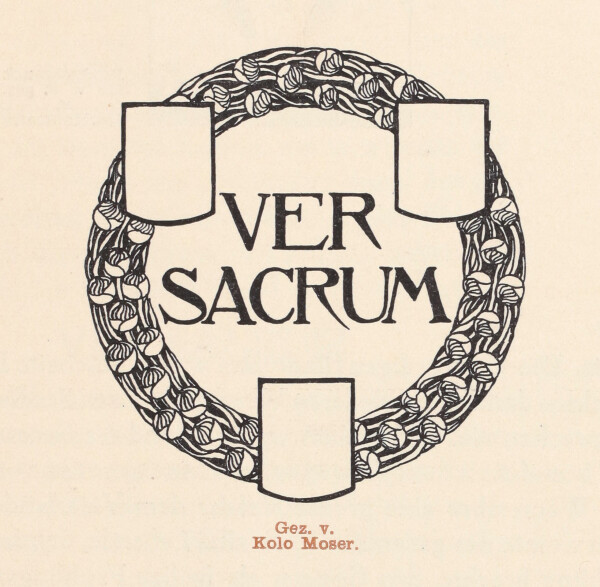
Kolo Moser: Vignette from the first Ver Sacrum booklet, 1898
© Klimt Foundation, Vienna
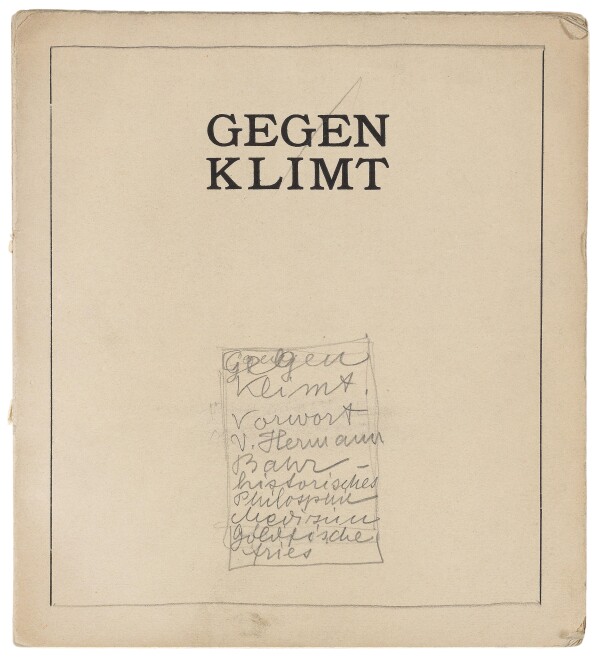
Kolo Moser: Printed Work "Gegen Klimt" by Hermann Bahr with Handwritten Notes by Kolo Moser, circa 1903, Österreichische Galerie Belvedere, Archiv, Partial Estate of Kolo Moser
© Dorotheum Vienna
Kolo Moser, the “master of a thousand arts,” was active in all fields of arts and thus personified the idea of the Gesamtkunstwerk. Moser and Gustav Klimt were friends and collaborators.
Kolo Moser’s Training and Early Career
Koloman Josef Moser was born on 30 March 1868 and grew up on the premises of the Theresianum boarding school (Vienna-Wieden, now 4th District of Vienna). His father was the school’s property manager. As a boy, Kolo thus had access to the school’s workshops. In his autobiography, written in 1916, he summed up this experience:
“Many people would later marvel at my versatility, which helped me pick up the techniques of various trades, arts and crafts […]. I studiously watched the servants executing their trades and soon learned their every movement. […] This alone has made it easy for me to familiarize myself with the topics of arts and crafts.”
In 1885 he took the admission exam for the Vienna Academy of Fine Arts. He was taught by Franz Rumpler and his colleagues Christian Griepenkerl and Mathias von Trenkwald. Around 1890 – in 1892 at latest – he founded the so-called Siebener-Club together with Josef Hoffmann, Josef Maria Olbrich, Joseph Urban, Adolf Karpellus, Leo Kainradl and Ludwig Koch. The artists’ association was one of the hotbeds of the Vienna Secession and the Hagenbund. From 1893, Moser attended the Imperial-Royal School of Arts and Crafts, where he was for instance taught by Franz Matsch.
Moser’s First Meeting with Gustav Klimt
Moser’s talent was noticed early on and he soon received his first commissions. In 1895 he created several contributions to the portfolio Allegorien. Neue Folge [Allegories. New Series]. Gustav Klimt had also been commissioned by the publisher Martin Gerlach to create works for the portfolio. In 1896, Moser finally met Klimt at the Künstlerhaus, where these works were being exhibited. He was studying Klimt’s allegoric depiction of Sculpture (1896) for the above-mentioned portfolio, when the master painter suddenly appeared. Moser recorded this fascinating moment in his memoirs:
“Even though I had already been enthralled by Klimt’s earlier works […] this drawing suddenly confronted me with something completely new […]. Klimt had developed his own typical style. When I was […] still studying the work, I heard that Klimt was coming and retreated to a side room, greeting him in passing. This was my first meeting with Gustav Klimt […].”
Moser graduated the same year and became a member of the Cooperative of Visual Artists in Vienna (now Künstlerhaus, Society of Visual Artists in Austria).
Moser and the Novelties of the Vienna Secession and the Wiener Werkstätte
His membership was short-lived, however, as Moser left the cooperative together with Klimt and other artists in 1897. Around the same time, the Vienna Secession was founded, with Klimt as its first president. The following year, the association moved into the Secession building, designed by Joseph Maria Olbrich. Moser played a significant part in the building’s decoration, creating the fresco Dance of the Wreath Bearers, which decorated the rear facade but was demolished in 1907, the stylized Owls as well as the polychrome rose window Archangel of the Arts, which was destroyed in 1945. Moser continued to influence any aspect of design in the avant-garde group. Together with Hoffmann and Alfred Roller he was responsible for the graphic concept of the magazine Ver Sacrum, the Secession’s official publication, creating around 150 illustrations. He also designed the emblem of the new association. Furthermore, Moser regularly exhibited his own works at the Secession.
His career progressed steadily. In 1899 he was given a temporary position as a teacher at his former school, where he became a professor in 1900. About two years later, he moved into a duplex villa he shared with Carl Moll in the Künstlerkolonie, an artists’ colony which had been built by Hoffmann on Hohe Warte. In 1903, he founded the Wiener Werkstätte together with Hoffmann and the textile manufacturer and patron of the arts Fritz Waerndorfer. The same year, Hermann Bahr published a compilation of press articles titled Gegen Klimt [Against Klimt], prompted by the scandal surrounding the exceptional artist’s Faculty Paintings. A printed work with notes in Moser’s handwriting suggests that Moser was involved in the design of the layout. Moser was also responsible for the design of the “XVIII. Ausstellung der Vereinigung bildender Künstler Österreichs Secession Wien” [“18th Exhibition of the Association of Austrian Artists Vienna Secession”], which was held towards the end of the year and was also called the “Kollektiv-Ausstellung Gustav Klimt” [“Gustav Klimt Collective Exhibition”]. In the following year, Moser and Hoffmann collaborated on the decoration of the “Schwestern Flöge” fashion salon. In 1905, Moser left the Secession together with the so-called Klimt Group. He married the graphic artist Editha Mautner-Markhof in July of the same year.
Kolo Moser, “Master of a Thousand Arts”
The poetic epithet given to him by Hermann Bahr illustrates Moser’s artistic versatility. Even though graphic works were his preferred medium, he also made a name for himself as a designer of countless arts and crafts objects, from furniture and entire interiors to fashion, jewelry designs and stage sets. He even became an expert in exhibition design. Berta Zuckerkandl remarked:
“Nobody can present a picture to its greatest effect in a room better than he.”
Moser also worked as an architect. Together with Hoffmann he built the Purkersdorf Sanatorium between 1904 and 1906, using fundamental design elements from the “Gustav Klimt Collective Exhibition.” In the following years, he contributed to the interior decoration of Otto Wagner’s Church at Steinhof.
After withdrawing from the Wiener Werkstätte due to doubts about its business model, Kolo focused on painting from 1907. The Swiss artist Ferdinand Hodler, who had already exhibited his works at the Vienna Secession in 1904 and with whom Moser corresponded regularly, became an important source of inspiration. Moser was also inspired by Klimt’s landscapes. In 1908, Moser, the “master of a thousand arts,” also participated in the “Kunstschau Wien”. He not only presented his own works but also played a key part in designing the room reserved for Klimt’s art. Peter Altenberg described this part of the exhibition as the “Klimt Church of modern art.” Kolo also participated in the “Internationale Kunstschau” in the following year. Around 1911, the Mosers purchased Klimt’s Faculty Paintings Medicine (1900–1907, destroyed by fire at Immendorf Castle in 1945) and Jurisprudence (1903–1907, destroyed by fire at Immendorf Castle in 1945). Medicine went to the Austrian State Gallery (now Austrian Gallery Belvedere, Vienna) in 1919 and Jurisprudence was integrated into the Lederer Collection. Like Klimt, Moser also participated in the “Esposizione Internationale di Roma” [“International Art Exhibition of Rome”]. In 1913, he initiated the founding of the Austrian Werkbund together with Hoffmann.
The Last Years of His Life
Moser was diagnosed with cancer in 1916. He succumbed to his severe illness two years later, on 18 October 1918. Klimt, Otto Wagner and Egon Schiele also died the same year. Like Gustav Klimt, the Universalkünstler [universal artist] Kolo Moser was laid to rest at the Cemetery in Vienna-Hietzing, 13th District.
Literature and sources
- Kolo Moser Werkverzeichnis. werkverzeichnisse.belvedere.at/online/355447/koloman-moser/content (03/27/2020).
- Christoph Thun-Hohenstein, Elisabeth Schmuttermeier, Christian Witt-Dörring (Hg.): Koloman Moser. Universalkünstler zwischen Gustav Klimt und Josef Hoffmann, Ausst.-Kat., MAK - Museum of Applied Arts (Vienna), 19.12.2018–22.04.2019; Museum Villa Stuck (Munich), 23.05.2019–15.09.2019, Vienna 2018.
- Rudolf Leopold, Gerd Pichler (Hg.): Koloman Moser 1868−1918, Ausst.-Kat., Leopold Museum (Vienna), 25.05.2007–10.09.2007, Munich 2007.
- Maria Rennhofer: Koloman Moser: Leben und Werk 1868-1918, Vienna 2003.
- Marian Bisanz-Prakken (Hg.): Heiliger Frühling. Gustav Klimt und die Anfänge der Wiener Secession 1895–1905, Ausst.-Kat., Albertina (Vienna), 16.10.1998–10.01.1999, Vienna 1999.
- Hermann Bahr: Der englische Styl, in: Oesterreichische Volks-Zeitung, 25.11.1899, S. 1-2.
- Berta Zuckerkandl: Koloman Moser, in: Die Kunst. Monatshefte für freie und angewandte Kunst, Band 10 (1903/04), S. 341.
- Koloman Moser: Mein Werdegang, in: Velhagen & Klasings Monatshefte, 31. Jg., Heft 2 (1916), S. 254-262.
- Peter Altenberg: Kunstschau 1908 in Wien, in: Wiener Allgemeine Zeitung, 09.06.1908, S. 2.

